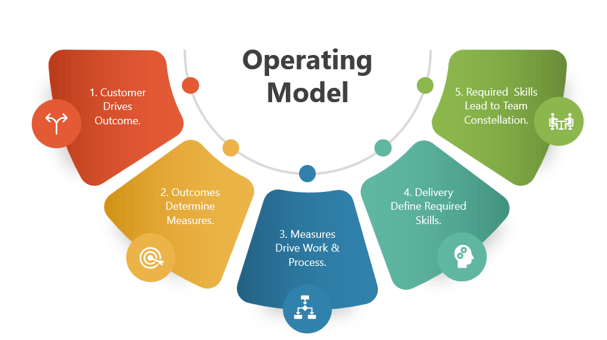A good operating model propels growth- and people-centric companies toward heightened market agility and innovation, while cultivating exhilarating collaboration.
An operating model is a blueprint of how an organization functions to deliver value to its customers, encompassing its processes, technology, governance structures, and workforce capabilities. It is the critical link between strategy and execution, translating the organization's vision into practical, day-to-day operations. Working on refining and optimizing the operating model is essential because it directly impacts the efficiency, agility, and innovation capacity of the business. By ensuring that all elements of the operating model are aligned and efficiently integrated, organizations can significantly enhance their ability to respond to market changes, improve customer experiences, and achieve competitive advantage. In essence, the operating model is not just about operational efficiency; it's about setting the foundation for sustained success and growth in an ever-changing business environment.

Many organizations design their operating models based on existing skills and technologies, but this approach can be a pitfall, necessitating eventual modernization or innovation. Long-term competitiveness hinges on the ability to pivot from what you currently have to what your customers need, aligning capabilities with market demands rather than internal resources.
The graphic above depicts our collaboration as well as our thought process. The image depicts a circular, segmented model that illustrates a customer-centric approach to operating model modernization, emphasizing the importance of starting with the end in mind:
1. Your Customers Determine the Outcomes: This segment indicates that understanding customer needs is the primary focus and starting point for defining successful outcomes for the organization.
2. The Outcomes Determine the Required Measures: Once outcomes are defined based on customer needs, appropriate measures are developed to evaluate success.
3. The Required Measures Determine the Work and Processes: The work or tasks necessary to achieve these outcomes are shaped by the measures established.
4. The Required Delivery Determines the Necessary Skills: The specific work then dictates the skills required to perform it effectively.
5. The Necessary Skills Lead to the Team Constellation: Finally, the teams are formed based on the skills necessary to execute the work and ultimately deliver the outcomes that meet customer needs.
This cyclical model underscores the iterative nature of modernizing an operating model, where each component is interdependent and ultimately geared towards satisfying customer requirements, which is the central tenet of the approach.
 Thanks to this process, we were able to facilitate and enjoy a challenging exponential growth phase. We found LC GLOBAL®s holistic, collaborative, and strengths-based approach especially valuable. Tenured and new members explored how to make even better use of our success factors and cultural values in our daily collaboration. Thank you LC GLOBAL®!
Thanks to this process, we were able to facilitate and enjoy a challenging exponential growth phase. We found LC GLOBAL®s holistic, collaborative, and strengths-based approach especially valuable. Tenured and new members explored how to make even better use of our success factors and cultural values in our daily collaboration. Thank you LC GLOBAL®!
CEO - GABO: mi
![]() Many staff members remarked that it was one of their best experiences as an employee of the College. Many students felt a stronger sense of being valued and connected as a result of this initiative. Due to the tremendous success, we brought LC GLOBAL® back to continue with this process on our other campuses.
Many staff members remarked that it was one of their best experiences as an employee of the College. Many students felt a stronger sense of being valued and connected as a result of this initiative. Due to the tremendous success, we brought LC GLOBAL® back to continue with this process on our other campuses.
Dean - Cochise College, Arizona
![]() I highly recommend the process to any team, group, or company that would like to scale while driving engagement and improving its culture and collaboration.
I highly recommend the process to any team, group, or company that would like to scale while driving engagement and improving its culture and collaboration.
Director of Growth - IBM
 Outstanding service, deep competence, and professionalism describe LC GLOBAL® for me.
Outstanding service, deep competence, and professionalism describe LC GLOBAL® for me.
SVP Global HR - Microsoft

New York City Office:
LC GLOBAL Consulting Inc.
641 Lexington Avenue, 13th Fl.
New York, NY 10022, USA
Munich, Germany Office:
LC Global GmbH
Oberländerstr. 38
81371 Munich, Germany
New York City Office:
Munich, Germany Office: